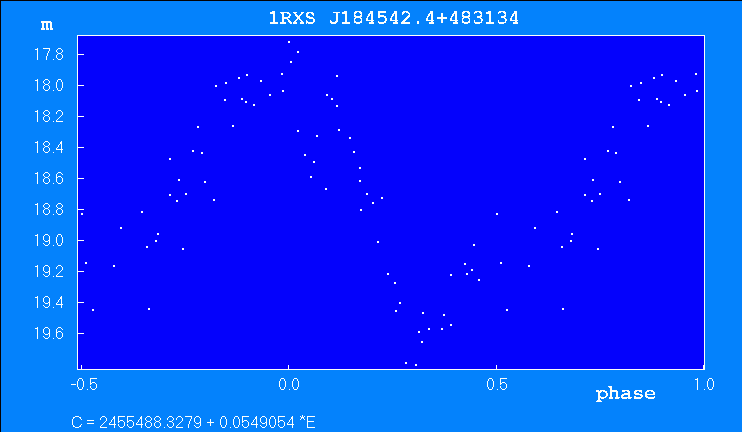"Peremennye Zvezdy",
Prilozhenie,
vol. 11, N 10 (2011)
Prilozhenie,
vol. 11, N 10 (2011)
1RXS J184542.4+483134: a New Cataclysmic Variable with Short-Period Photometric Variations
D. Denisenko#1, E. Smirnov#2
#1. Space Research Institute (IKI), Russian Academy of Sciences, Moscow, Russia;
#2. Sankt-Petersburg, Russia
#2. Sankt-Petersburg, Russia
Received: 2.12.2010; accepted: 24.03.2011
(E-mail for contact: epsmirnov@yandex.ru)
| ||||||||||||||||||||||
Remarks: |
| The long-term optical variability of 1RXS J184542.4+483134 (RX J1845.7+4831) was
found by Denisenko and Sokolovsky (2010) who used their method of
data analysis in 1RXS and USNO-B1.0 catalogs. The X-ray source, previously without
an optical identification, could be identified
with USNO-B1.0 1385-0291789 inside the ROSAT error box. The object's B1.0 magnitudes
for two epochs differ by almost 5 magnitudes
(B1 = 21.32, B2 = 16.61). Based on the X-ray hardness ratios,
archival light curve from the Palomar Digitized Sky Survey plates, and no information
on a detected proper
motion, the object was assumed by Denisenko and Sokolovsky to be a quasar. Other
indirect arguments in favor
of QSO classification were the presence of a galaxy within 1'E and 1'S of the variable
object
and a cluster of galaxies at about 2'W and 1'N. The object is located at galactic
latitude
b = 21°.
Following the announcement of the large-amplitude variations at an astronomy forum,
one of the authors (E.S.) started CCD monitoring at a private observatory. On September
25–November 5, 2010, a total of 73 unfiltered images with 200-second exposure
times were
taken. A Sky Watcher 12" Newtonian telescope and a SBIG402ME CCD camera (Kodak KAF0402
chip, Peltier cooled) were used. The reductions of CCD frames and photometry analysis
were carried out with the CCDSoft, MuniWin packages and WinEffect software by V.
P. Goranskij. USNO-B1.0 1385-0291764 (R = 15.5) was used as a comparison star
and USNO-B1.0
1385-0291771, as a check star.
Our observations show a high-amplitude, short-term variability of the object
that rules out the QSO classification. The photometric period, probably reflecting
the orbital period, was found to be 0.05491(1)
d, or 79.07(1) min. Such a short value is typical of dwarf novae of UGSU or
UGWZ types. The light curve shape is well described by a quasi-sinusoidal wave typical
of a
reflection
effect caused by irradiation of the red dwarf by a hot compact primary object, with
two 0.2-mag humps shifted in orbital phase by about 0.2 and 0.7 with respect to minimum
light, and a narrow eclipse-like dip by 0.8m at about 0.1 P after the maximum.
This dip can be explained by a self-eclipse of the accretion stream or by an eclipse
of
the hot spot on the surface of the white dwarf.
The most remarkable feature of RX J1845.7+4831 is the full amplitude of sinusoidal
wave of 1.8m, not observed in cataclysmic variables before. For instance,
Woudt
and Warner (2003), discussing the light curve of RX J1039.7-0507 (YY
Sex) with an orbital period of 0.0656 days, claim that the star's 1.1-mag sinusoidal
modulation requires a very hot primary, probably having undergone a nova eruption
in the past 10–20 years. This hypothesis can be also applied to RX J1845.7+4831
to
explain why the 1990 Blue Palomar plates show it brighter by at least 1m (at 16.6m)
than its current brightness at maximum and even by 2m brighter than the 79-minute
averaged brightness. The long maximum
(more than 25 days in duration), covering the 1990 June 26 and July 21 plates
and originally interpreted as a QSO outburst, could have been a fading phase with
rebrightenings
after
an UGWZ or classical-nova outburst. This is also supported by the fact that
the variable has not yet returned to its pre-outburst quiescent level of 21m which
is recorded by the Palomar plate of the first epoch.
It should be noted, however, that even the classical Nova Cygni 1975 (V1500 Cyg)
had a modulation range of only 1.2m 12 years after the eruption, reducing to 0.7m
by 1995
(T+20
years). Thus, the 1.8-mag modulation in RX J1845.7+4831 about 20 years after its
possible
outburst in 1990 is unprecedented for cataclysmic variables. A reflection effect
that large (or even larger)
is observed for low-mass X-ray binaries. This might mean that RX
J1845.7+4831 is an X-ray binary with a neutron-star primary. A definite final judgment
on
the nature
of this object requires time-resolved spectroscopy.
We also encourage follow-up photometric observations in order to monitor for
a future
possible outburst of this system. |
| References: |
| Denisenko, D.V., Sokolovsky, K.V., 2010, arXiv:1007.1798v1
Woudt, P.A., Warner, B., 2003, Monthly Notices of the Royal Astron. Soc., 339, 731 |
Light Curve
The light curve of J184542+483134 with P = 0.05491d. Finding Chart 
The finding chart for the variable star J184542+483134. 10'x 10'. Data Source |